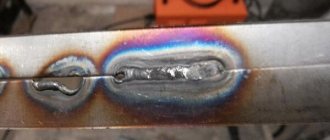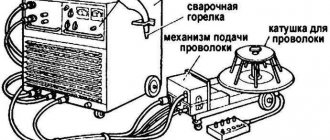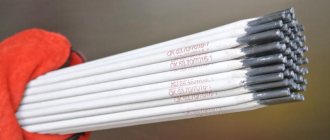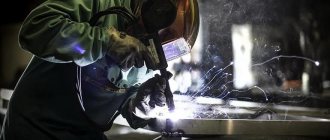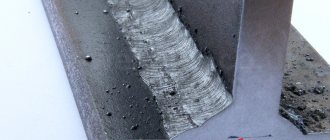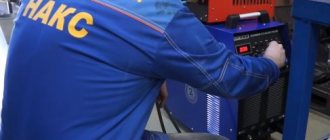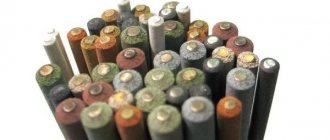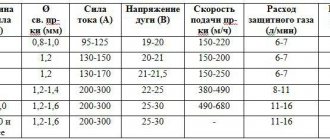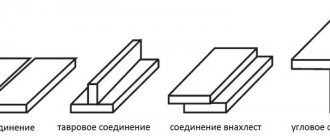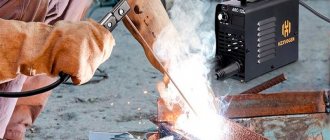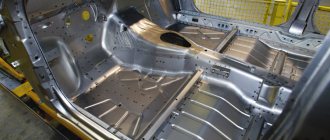Purpose and design of the ballast rheostat
To form a steeply falling current-voltage characteristic of the operating current during welding, the ballast rheostat must perform two functions: discretely regulate the current strength, and compensate for its constant component, which occurs when the welding station is powered from a transformer.
The effectiveness of a ballast rheostat is determined by the number of its working sections, each of which is a serial electrical circuit consisting of a resistor with a certain resistance and a switch that mechanically breaks this circuit. The sections are connected in parallel, which creates the best opportunities for the combined inclusion of each of them in the work. As a result, the current can be adjusted in steps of 5...10 A, which in most cases is quite sufficient. The ballast rheostat is connected in series with the current source into the common circuit of the welding station.
Structurally, the ballast rheostat is a unit consisting of:
Closed, ventilated housing. Several boards made of nichrome or constantan tapes. Breakers, the number of which corresponds to the number of control stages. Terminals to which the welding machine cables are connected. Block for switching on the required welding range.
All controls are displayed on one of the external panels of the case. In the most modern designs of ballast rheostats, fans are built into the housing to eliminate overheating of the device during prolonged operation at high currents (otherwise, several ballast rheostats have to be connected in series), as well as capacitor banks that compensate for the direct current component that occurs during special welding processes , in particular aluminum.
The RB line of the most common ballast rheostats, made according to the scheme described above, includes the following standard sizes:
- RB-201 – regulates current in the range from 10 to 200 A;
- RB-300 – regulates current in the range from 10 to 300 A;
- RB-302 – regulates current in the range from 10 to 315 A;
- RB-306 – regulates current in the range from 6 to 315 A;
- RB-501 – regulates current in the range from 10 to 500 A.
Device
The design of the ballast rheostat is quite simple: it consists of working sections placed in the body of the device. A resistance switch is installed on each section, with which you can turn the sections on and off. The device also includes terminals for connecting to the welding circuit.
Each section is a tape made of a special metal, for which constantan or nichrome wire is usually used. Also, most machines are equipped with a switching unit that allows you to adjust the welding range to the required level.
All controls, including the power unit and toggle switches, are usually located on one panel of the device.
It should be noted that most modern rheostat models are equipped with a cooler system for cooling the device, represented by built-in fans. This system helps to avoid overheating during prolonged operation of the device. This allows you to operate at high currents without the need to connect an additional rheostat.
Ballast rheostat circuit
It should be noted that when overloaded, this device is characterized by significant heating, which occurs at a current strength of 225 A. Therefore, it is recommended, in order to avoid embarrassment and malfunctions, to include two rheostats in the circuit.
Ballast rheostat RB-306
RB-306 is the next generation from the well-known line of rheostats. This type is intended to be a solution to problems that often arise when using RB-302. Among them are frequent breakdowns of resistors and overheating of the device itself. When developing a new model, all the shortcomings of the previous device were corrected.
The improved arrangement of working elements allows you to quickly and easily check and replace them.
Ballast rheostat RB-306
This device allows you to cut metal. To do this, you need to assemble a block of the above rheostats, which is used together with a rectifier.
To use the rheostat effectively, you must adhere to certain rules, among which are compliance with climatic conditions, cleanliness of the working area, as well as constant diagnostics of the device for serviceability. This is best done in special service laboratories.
How to assemble a tractor
To mount tractor units on the frame, you will need the ability to select spare parts from other mechanisms. During assembly, the master must carry out the following stages of work:
- installation of undercarriage based on wheels or tracks;
- installation of engine and clutch;
- creation of brake and steering systems;
- seat mount.
It is better to make the front axle for breaking yourself, from a steel rod at least 5 cm thick. In the middle of the part you need to install a hinge joint that will ensure the mobility of the bridge on uneven roads. Equip the ends of the homemade beam with ears for attaching axle shafts with hubs. To lubricate the system, install a separate oil tank. A distributor for front-wheel drive cars or tractors in Belarus will help make these wheels drive.
When creating a mini tractor with your own hands with an Oka engine, the easiest way is to use standard brakes and clutch. On a solid frame, this part of the assembly should not cause any difficulties, especially when using axles from the same car. Only the problem of placing the engine itself is solved individually.
When working with a broken frame and a homemade front axle, you can use parts from other cars. In this case, they are adjusted to fit existing structures. When making a crawler-mounted tractor, you will need to purchase tracks and rollers for them, which will significantly complicate the work.
Steering involves a standard procedure for installing linkages that match the chassis used in the design. Both the Oka unit and the corresponding motorcycle part are used as the steering column.
We suggest you familiarize yourself with heating a greenhouse with your own hands: how to make water heating in winter, with wood or air
Ballast rheostat settings
The main thing in a high-quality welding process is stable performance of the electric arc, or rather, its current-voltage characteristics. Modern inverters cope well with this requirement.
Marking of ballast rheostat.
This is done by converting the current into two stages and switching the inverter itself. All other welding machines cannot boast of such characteristics. Therefore, a ballast rheostat must be present next to them.
It is designed for stepwise control of arc operation and compensation of the current component during recharge from the transformer. Nichrome wire in a parallel connection circuit is the main component
It is important that each section of the rheostat is connected to the network independently, using a switch
Such a rheostat has only two working functions:
- Current regulation in a discrete manner.
- Compensation of the direct current component formed during the feeding of the welding element using a transformer.
The performance and overall efficiency of a ballast rheostat directly depend on the number of turns or sections of the spiral. After all, each of them is an element of a chain that is broken using a switch.
The circuit is serial, and the connection of sections is parallel. This combination gives an excellent result: periodically connecting each of the elements to the work in order to regulate the voltage in the welding machine.
The connection of the rheostat to the welding circuit must be in series with the power source.
Control buttons are always located on the outer wall of the protective metal case. The most advanced rheostatic models have internal fans that cool the device’s elements while operating at high current levels.
If there are no fans, you must ensure that several rheostats are switched on in series.
The most popular line of ballast rheostats on the market under the abbreviation RB: there are only five options for different current values - its range - minimum and maximum values.
We offer an easy walk through the most popular models to get acquainted with their technical characteristics in more detail:
RB-302
Ballast RB-302.
An excellent device as a companion to welding units for adjusting the current strength in semi-automatic or manual welding processes. Works in parallel with welding rectifiers and generators.
This version is designed for a power supply range of 27 - 30 V with a maximum maximum of 70 A and a minimum drop of 30 A.
The rheostat is equipped with an air cooling system. It has a good PV indicator - the on-time is 60%. This means that the welding duration should not exceed 10 minutes. Otherwise, the PV must be reduced.
In this device, the welding current adjustment is represented by six steps, which are cyclically turned on and off.
The structural elements are made of the most modern materials: the insulation, for example, is made of ceramic profiled plates, and the plateau is formed from special heat-resistant fechral wires.
RB-302U2
This model is a type of mother rheostat for operation in conditions of high humidity or harsh ultraviolet radiation. As a result, you can work with it outdoors in conditions unfavorable for conventional equipment.
RB-306
This model is more serious: it does not overheat and is much more accurate in regulating the welding power supply than the RB-302. The rheostat is equipped with an improved cooling system: there are more blind holes in the body, so the blowing of the resistors is intense and efficient.
Electrical circuit of the ballast.
All resistance elements are arranged in a modular system. This arrangement makes diagnosing and replacing elements much easier and more accurate. The range of current values is much wider, and the indicators can be adjusted with much greater accuracy.
BBR
These are special Ballast Rheostat Blocks. They are assembled from RB-306 elements for cutting metals using the electric arc method. This is an excellent solution for controlling the welding current from the rectifier in automatic machines.
What is the correct name for a grinder tool?
First, let's figure out what a “grinder” is. The name “grinder” is very strongly attached to this instrument. In professional language, this tool is called an angle grinder (angle grinder). But historically, this tool was first assembled in Bulgaria, which is why the name “grinder” was attached to the angle grinder.
Why do you need a grinder?
A grinder or angle grinder performs a simple function - grinding. But many craftsmen use angle grinders not only for grinding, but also for working on concrete, metal and even wood. But this tool was originally created only for grinding, however, a modern grinder can easily cut, polish and clean materials.
At the same time, grinding and cleaning can be done with almost any material that comes to hand. To do this, use various nozzles, each suitable for its own type of material. Angle grinders can process: cement, concrete, slate, brick, glass, porcelain, wood and even plastic.
The main advantage of this tool is that it is almost universal; you only need to change the attachments.
The first criterion is the size of the disk used
The most important and first criterion that you need to decide on when buying an angle grinder is the size of the disc used. At the moment, the minimum size of a cutting disc is 0 115 mm, and the maximum possible size is 230 mm.
Just note that not the entire part has the ability to cut, but only the one protruding beyond the body of the angle grinder. This means that if the case is at least 55mm wide, then about half of a 115mm disc (even less) can cut something. Simply put, a 115 mm grinder can cut a board no thicker than 30 mm (and in practice, a maximum of 25 mm). At the same time, all disks tend to wear down, that is, in a minute of operation this figure can be halved. Based on this, you can already think about the size of the disk.
After all, for cutting metal pipes with a diameter of 20 millimeters or more, a 115 mm grinder will no longer be appropriate due to low wear resistance. And if you buy an angle grinder for cutting pipes, then at least 180 mm. And this is only for cutting, but what if you need a tool for grinding? There is no need to take more here; it will be enough to choose a tool for 125 mm, which is the norm for most grinding attachments.
As you noticed, choosing is not so easy; you first need to think about what the tool is needed for, and only then start selecting it.
Let us characterize the types of angle grinders based on size so that we can more easily understand what will suit us best.
Angle grinder 115 mm
This is the smallest saw blade size that can be purchased. It is suitable for the simplest work, and often, wheels of this diameter are used exclusively for grinding, since the smaller the size, the less the weight. This is the best option for small jobs.
Angle grinder 125 mm
This is the next largest type and at the moment it is the most popular among our population. Grinders of this size are not heavy, but very comfortable and have decent power characteristics, and, importantly, still have a low cost. This grinder can be used for both grinding and cutting. Of course, such an angle grinder will not be able to handle parts that are too thick, since the depth of penetration of the blade is much less than the radius, but for household work this grinder is just right.
Angle grinder 150 mm
This type of grinder is not very popular in everyday life, but is sometimes in demand. This grinder is somewhat more powerful than the previous ones and allows you to perform more voluminous work.
Angle grinder 230 mm
This is the maximum you can buy based on the diameter of the circle. The most important advantage of such an angle grinder, of course, is in a large circle. With this tool you can cut bricks, tiles, boards and even pipes without much effort, but it is better not to use such a grinder for grinding. Firstly, it has a very large weight, which is extremely inconvenient when grinding material, and secondly, a large circle will prevent you from getting to narrow grinding spots. You should buy such an angle grinder only if you are planning a major renovation or large-scale construction. This grinder is not suitable for small jobs
How it works?
At its core, it is a ballast rheostat - a special device for generating increased resistance for welding electricity. This rheostat is distinguished by its simplicity. It is built into many advanced and expensive models of welding machines, and can also be purchased separately.
In addition, you can build a ballast yourself without any problems. It should be noted that every self-respecting welding master has such a device in his storage room.
According to the principle of its operation, the welding ballast is a point of obstacle in the path of the movement of electric current; it is a “point” of high resistance. From an external point of view, it looks like a complex thick spring.
Why do you need a ballast?
This spring is always equipped with a movable contact, which, when moving along the spring, changes the length of the path that the current passes through the ballast.
This device cannot boast of a particular variety of models.
There are some differences, they are determined by the following criteria:
- Dimensions of the spring: the longer it is, the longer the path of electrons through all turns of the rheostat, the greater the resistance reduces the current strength.
- The nature of the metal with certain resistance coefficients.
- The thickness of the spring is also directly proportional to the resistance force. The thickness is related to the length of the rheostat.
In fact, it turns out as follows: without a ballast rheostat, the current would have a force of 250 A. If you connect a ballast to this circuit, the electric flow will begin to lose strength and would have only 10 A at the output.
Of course, the regulator can change the length of the spiral path along which the flow passes. The losses in this case would be different.
How to make a ballast with your own hands?
The first step is to find a suitable metal wire. It could be, for example, copper. Additionally, you will need a cylindrical shape, for example, a pipe and an ammeter. You need to think about what to make the moving contact from; it could be a wire.
The straight wire needs to be turned into a tight spring. To do this, it is wound onto a cylindrical shape, trying to place the turns as close to each other as possible. The end of the twisted wire must be connected to the wire for current. We also attach a moving contact.
The next step is very important: you need to check the operation of the new rheostat with help. Ammeter. The fact is that a homemade ballast for a welding machine is not as accurate as factory models.
The next caveat is that our rheostat is not equipped with a housing, so compliance with safety regulations becomes even more mandatory.
POSSIBLE MALFUNCTIONS AND WAYS TO DO THEM
Table 3 Name Probable cause Method of troubleshooting When the device is not working Loosening Tighten the contacts is provided by contacts for regulating the current at 6 and 10 A toggle switch terminals.
When the rheostat is operating, Loosening Tighten the threaded connections unsatisfactorily in the places where the currents are regulated through the connections at the contact points and contact stages
9. SERVICE LIFE AND STORAGE.
9.1 The service life of the rheostat is 5 years, subject to compliance with the rules of operation and storage.
9.2. Packaged rheostats can be transported by any type of transport, provided that the rheostat is protected from unacceptable climatic and mechanical influences.
9.3. The rheostat should be stored in a dry, ventilated room at a temperature from -200C to +450C and a relative humidity of no more than 80% at 200C. It is strictly forbidden to store materials in the same room with the rheostat, the vapors of which can cause metal corrosion and destruction of insulation (acids, alkalis, etc.).
9.4. The shelf life in the warehouses of trading enterprises is no more than 24 months from the date of release, after which it is necessary to remove the rheostat casing and inspect it.
10. ACCEPTANCE CERTIFICATE Ballast rheostat RB – 302/306 U2 serial number __________________ complies with the technical specifications TU 3441-008-24154334-2008 and is recognized as suitable for operation.
Release date: _________________________________2011
Quality control stamp ______________
Signature of the person responsible for acceptance: ______________________
11. WARRANTY
11.1. The manufacturer guarantees that the product meets the requirements of the technical specifications, subject to the conditions of transportation, storage and operation rules established by the technical specifications and this passport.
11.2. The warranty period for the product is 12 (twelve) months.
11.3. The warranty does not apply to products with:
a) mechanical damage or unauthorized design changes;
b) traces of outside interference or a repair attempt was made at an unauthorized service center.
c) damage caused by foreign objects, substances, liquids, insects getting inside the product;
d) damage caused by elements, fire, household factors;
e) malfunctions resulting from overloading of the product, resulting in failure of components and parts.
Unconditional signs of product overload include, but are not limited to: changes in appearance, deformation or melting of parts of product components, darkening or charring of wire insulation under the influence of high temperature.
Attention: Before putting the product into operation, carefully read the instructions. Violation of operating rules entails termination of warranty obligations to the buyer
If a malfunction of the product occurs during the warranty period, the buyer must contact the trading organization where the product was purchased or the manufacturer.
Manufacturer's address:
Manufactured by Modern Welding Equipment LLC specifically for PKP Plazer LLC
344064, Rostov-on-Don, st. Vavilova, 69.
How to adjust the current of a welding machine?
The diodes can be replaced with any with similar parameters D226, 1N4007, etc. C1 can be within 0.1-2uF, it eliminates engine jerks at low speeds. Capacitors with an operating voltage of 250 volts.
You must be logged in to comment.
Most welding machines, especially homemade ones, are very far from perfect. We offer a diagram for fine-tuning a homemade welding machine from “change” to “permanent” with your own hands and you can use electrodes of any type (see Fig. 1).
Rice. 1 Diagram of a welding machine with a highly efficient inductive-capacitive filter that smoothes out rectified voltage ripples.
Let's go through the diagram.
Purpose
The purpose of the ballast rheostat is quite simple, but in some cases it is impossible to perform welding work without its function. This device is necessary to regulate the current strength in the required range using toggle switches and compensation of the constant component. This effect occurs in cases where welding work is performed from a transformer.
The efficiency and cost of the rheostat depends on the number of sections, with the help of each of which you can adjust the resistance level in a certain way. The switch allows you to mechanically break the chain.
Parallel connection of sections allows you to optimally combine the work of each, which is very important for the welding machine that performs the corresponding work. The current adjustment step is usually in the range from 5 to 10 A
Today, we should highlight a line of the most popular types of rheostats called RB. The marking of each device indicates the current range within which welding work can be performed.
Do-it-yourself assembly of a ballast for a welding machine, the pros and cons of a homemade device
Typically, low resistance is used in welding work, since this ensures that no current energy is lost. This is achieved by using low resistance materials as conductors.
The ballast is needed in order to create an artificially increased resistance, which may be necessary in some situations.
In this case, the current value is also higher than necessary and must be adjusted. The welding ballast helps to carry out welding faster and easier.
Ballast rheostat RB-302
Used for stepwise control of the welding current in manual and semi-automatic welding or surfacing of coatings using metal electrodes. Works in conjunction with generators and multi-station welding rectifiers. Designed to maintain the arc voltage within 27...30 V, the maximum voltage cannot exceed 70 A with a critical drop at the terminals - 30 A. Cooling - air, the recommended value of the duty cycle is 60...65% (if the duration of the welding cycle exceeds 10 min, then the PV value must be reduced).
The RB-302 rheostat can operate from a mains voltage of 220 and 380 V, and with any main source of welding current, except for TSD-300 welding transformers and VS-400 and VS-600 welding rectifiers. In these cases, it is necessary to connect two ballast rheostats, which are connected in parallel. The current strength will double.
The ballast rheostat model RB-302 has two operating ranges of welding currents: 5 A and 10 A, with the smallest value of the current difference in different stages being 10 A. The number of adjustment stages is 6, they are turned on and off using contact knives. The board of control branches is assembled on fechral heat-resistant wires with a diameter of 2.2 mm; profiled ceramic plates are used for electrical insulation.
Periodic monitoring of the operation of the RB-302 ballast rheostat is carried out by measuring the actual insulation resistance relative to the grounded body of the unit: the corresponding value must be at least 500 kOhm.
A variation of this model is the ballast rheostat type RB-302U2, which is equipped with an additional insulating cover and improved electrical insulation. This allows you to use the device outdoors and conduct safe welding in conditions of high ambient humidity or active ultraviolet radiation.
Ballast resistance for DIY welding
After all, what is a conductor?
This is a material with minimal resistance so that electric current passes through them with the same minimal losses. This is common practice. The exception is cases with tasks “on the contrary”: when resistance needs to be increased. This need arises when the current readings are too high and need to be regulated. It is for such purposes that a welding ballast exists. It makes welding easier and faster.
How to make a ballast for a welding machine with your own hands
The parameter of least resistance is extremely important, since the current passes almost unhindered and does not lose energy. For this reason, almost all conductors are made from materials with the lowest resistance.
But sometimes it is necessary to artificially simulate a situation of increased resistance, when the current indicator is too high and requires adjustment. For these purposes, there is a ballast for the welding machine.
With it you can carry out welding work easier and faster.
A ballast rheostat for welding or simply a ballast is a structural element or a separate device that creates increased resistance to current and thereby regulates its strength. This device is simple and reliable.
The ballast is found in many expensive welding machines, but it can also be purchased separately, which is not cheap. We suggest you make a ballast with your own hands.
The design of the ballast is simple and clear, so every welder can make it himself.
Capacitor welding review and production
Operating principle and design
So how does a ballast work? In simple terms, the current that flows unhindered through the circuit encounters high resistance at a certain point, due to which it loses its magnitude. The “culprit” of high resistance is precisely the ballast connected to the circuit.
Visually, the ballast for a welding machine is a large spring with many thick turns. This spring creates ballast resistance.
A regulator is connected to the spring, with which you can change the resistance value to more or less, and therefore change the current strength.
The regulator is a movable contact that is moved along and thereby reduces or increases the length of current flow through the ballast. Ballasts are an integral part of any experienced welder's arsenal.
CLASSIFICATION
Ballasts are almost the same in their operating principle or design, but may have a number of features. The range of values that we can choose to set the desired resistance will depend on them. So, ballasts differ in the following parameters:
- Spring length. Everything is simple here - the longer the spring, the longer it takes for the current to pass through all the turns.
- Metal. Ballasts are made of various metals, each of which has its own resistance coefficient. The more powerful and serious the welding machine, the more carefully the ballast material is selected.
- Thickness. Both individual turns and the entire spring as a whole. This determines how strong the resistance indicator will be. The thickness indicator is closely related to the length indicator.
DIY ballast
To make a ballast we need thick metal wire. We used copper wire in our work. You also need a cylindrical shape (it can be pre-welded from any thick metal or take a small-diameter pipe), materials for the movable contact (we used a wire from the welding machine holder) and an ammeter.
We wind the wire around a pre-made cylindrical shape, placing the turns at a distance of no more than a centimeter from each other. We connect one end of such a spring to the current-carrying part.
To this design we attach our wire from the holder, which will be used as a mobile contact.
Before you make a ballast rheostat for welding with your own hands, please note that a home-made device may work less accurately than a factory-made device. Also follow safety precautions, because homemade ballasts are not hidden in a metal case and may not be fastened securely enough, which can lead to dire consequences
Pattern of an envelope for a newborn with a hood: do-it-yourself cocoon and overalls
STRUCTURE AND PRINCIPLE OF OPERATION
A ballast rheostat, commonly called a ballast, is a mechanism that increases the resistance of the current and thereby controls its strength. The ballast is easy to use and reliable.
Most often, ballast is present in the design of expensive welding machines. If your device does not have it, you can find it in a special store, but the prices will be quite high.
The design of the device is clear to every welder, so you can easily make it yourself, with your own hands.
It looks like a spring with many turns of large diameter. It is responsible for resistance called ballast.
The device has a special regulator that allows you to increase or decrease the resistance, and, accordingly, change the current value. This regulator moves along the ballast rheostat, changing its length, that is, the distance that the current travels.
Thus, the resistance changes.
Setting methods
There are various methods for adjusting the voltage, we previously talked about the energy of the converted AC and the converted.
In reality, this is too broad a division, because the setting still has subtypes. We will not be able to talk in detail about the subspecies in this article, so we will discuss the more popular ones.
This method is considered safe and durable; it is easy to make a ballast yourself and use it for work without auxiliary equipment. Basically, the ballast is used only to reduce voltage.
We have already talked in detail about the intricacies of work and the use of a ballast for a semi-automatic inverter. There are important recommendations on how to make an electrical appliance at home and how to use it for work.
In addition to the advantages, a method of adjusting the energy of the converted alternating current, used in conjunction with an energy converter. It may not be so convenient for cooking, especially for inexperienced craftsmen.
Firstly, the ballast is of a sufficiently large size - up to 1 m long. Basically, such an electrical device is placed underfoot; it can become very hot, which violates safety rules.
If you are not satisfied with such qualities, then it is better to choose a method that includes adjusting the cooking voltage according to the energy of the converted alternating current.
For this, an electric current regulator for a welding machine is often used, which is easy to make yourself. Such a device is easy to adjust according to the energy of the converted alternating current and will be convenient for the master to work with.
An electric current regulator for a welding machine will be the first assistant in working in the country, where the power supply is often intermittent.
It happens that in houses it is impossible to use electrical appliances larger than 4 kW, which makes the work limited.
Another advantage of the current regulator for the welding machine is that it is easy to work with when you need to frequently change the place to do the work. There is no need to take the regulator device with you, like a ballast, it will not injure you.
Let's talk about making your own electrical control device from thyristors.
